Report of the Department of Justice on December 30, 2020 Use of Force by Delaware State Police
Scope of Investigation
This is the final report of the Delaware Department of Justice, Division of Civil Rights and Public Trust (“DCRPT”), arising out of the investigation into the use of deadly force by the Delaware State Police against Ronald Cochran (hereinafter “Cochran”). DCRPT reviewed evidence consisting of video footage, dispatch recordings, witness interviews, police interviews, scene photos, police reports, medical records, the toxicology report, and forensic firearms reports. Attorneys with DCRPT reviewed this use of force incident for the Department of Justice.
This report covers the non-fatal shooting of December 30, 2020, and it is the fifth report by DCRPT on a case involving a pending criminal defendant.1 As our reports seek to expand transparency and ensure trust in the process of reviewing the deadly use of force by law enforcement, we must stress that this report is wholly separate from the criminal proceeding – DCRPT’s investigators and prosecutors are not involved in the criminal case, nor are Criminal Division prosecutors involved in DCRPT’s decision-making. The outcome of Cochran’s criminal case must be determined solely and exclusively on the evidence presented at trial, and in accordance with the Court’s rules. This report in no way relieves the State of Delaware of its burdens at trial.
Purpose of the Department of Justice Report
The Department of Justice determines whether a law enforcement officer’s use of deadly force constitutes a criminal act. The Department of Justice does not establish or enforce internal police policies concerning the proper use of deadly force by law enforcement officers. Law enforcement agencies are responsible for establishing and enforcing guidelines for the use of force by their officers and for determining whether an officer’s actions were consistent with such guidelines in a given case. This report expresses no opinion whether involved officers’ actions complied with departmental policies or procedures.
Facts
On Wednesday December 30, 2020, at approximately 5:30 PM, Delaware State Police Trooper Joshua Cary, Trooper Schatzschneider Billy-Attoh, Jr., and Trooper Andrey Green were dispatched to 201 East Evens Road in Viola for a male subject, later identified as Ronald J. Cochran, discharging a firearm in the back of the residence. Trooper Cary and Trooper Schatzschneider Billy-Attoh Jr. arrived at the location first. They made contact with a civilian, Person One, who initially claimed s/he did not know Cochran. As Troopers were talking with a neighbor, Person One approached Trooper Billy-Attoh and informed him that Cochran was in the bathroom of the residence and threatening to “shoot up the place.” Trooper Green arrived on- scene and watched the front of the residence while Trooper Cary and Trooper Billy-Attoh attempted to contact Cochran who was inside the residence.
As Troopers were attempting contact with Cochran, Trooper Cary saw Cochran through the doorway, with a handgun, fleeing to the second floor of the residence. Trooper Cary gave several verbal commands for Cochran to drop the gun and come outside – but Cochran continued to the second floor. Trooper Cary observed Cochran exit a second-floor window on the rear of the residence with a gun in his hand, pointing it in the direction of the Troopers. Trooper Cary had his flashlight illuminating Cochran because of the darkness but could clearly see the firearm. Trooper Cary ordered Cochran to drop the gun and put his hands up. Instead, Cochran fired the pistol at Trooper Cary. Trooper Cary returned fire and sought cover. Cochran moved across the rooftop, while shooting at both Trooper Cary and Trooper Billy-Attoh. The Troopers were on the ground in the rear of the residence, looking up to the first floor roof, and Trooper Billy-Attoh returned fire.
Both Trooper Cary and Trooper Billy-Attoh heard Cochran yell “ow!” and noticed blood on the siding of the residence. Cochran jumped from the second floor and landed on top of a metal “Bilco” door before fleeing toward the front section of the property.
Trooper Green was still watching the front of the residence and, upon seeing Cochran, discharged his weapon as he saw Cochran raising his hand toward him. Cochran fled toward a tree line and disappeared out of sight before being located at a neighbor’s front porch. Cochran was taken into custody and the firearm was in his possession. Cochran was treated for his injuries and released from Bayhealth in Dover into the custody of the Delaware State Police.
Police Witnesses
Trooper Joshua Cary
Trooper Cary has been a Delaware State Trooper since March 2015 and is assigned to the patrol division at Troop 3 in Camden. Trooper Cary is also a team member on the DSP Special Operations Response Team (SORT) (Other departments may refer to this unit as SWAT).
Trooper Cary was on routine patrol on the evening of the incident when he was dispatched for a disorderly subject firing rounds in the backyard of a residence. Trooper Cary said he was the first officer to arrive on-scene and, upon seeing the residence, recognized it was a home he had been to before for a disorderly and suicidal subject. Trooper Cary stated he knew from his past experience to use the rear door to the residence as the primary entrance. Trooper Cary said he knocked on the rear door and was greeted by a subject later identified as Person One. Trooper Cary stated he did not believe the subject answering the door was Cochran because of the age provided to him by dispatch. Trooper Cary said Person One said Ronald Cochran doesn’t live at the residence and told him to check the residence behind the house. Trooper Cary said that he then went to contact another person (Witness Six) the area, who advised they didn’t know a Ronald Cochran. During this time, Trooper Billy-Attoh and Trooper Green had arrived on scene to assist.
Trooper Cary reported that as he was talking with a another person in the area, Person One told Trooper Billy-Attoh that a man was in his bathroom and that the man was going to “shoot up the place.” As a result, Trooper Cary approached Person One and asked him where Cochran was within the house. Person One told Trooper Cary that he would get the gun from Cochran and turned away from the door and back into the residence. Trooper Cary could tell Person One was intoxicated and could hear Person One talking to Cochran inside the house. Trooper Cary could hear Person One tell Cochran to give him the gun and that the State Police are outside and they have their guns drawn. At this point, Trooper Cary yelled to Cochran, “[T]his is the State Police, come outside with your hands up.” Trooper Cary could see Cochran push past Person One and run deeper into the residence. Trooper Cary said the police set up a perimeter around the residence. Trooper Cary was with Trooper Billy-Attoh in the rear of the residence, and Trooper Green covered the front of the residence. Trooper Cary heard a window opening on the second floor, so he started to seek cover by a large tree.
Trooper Cary didn’t have a clear view of the window, so he moved to get a better view because he was not sure if it was Cochran or someone else trying to flee the residence. Trooper Cary used his flashlight to illuminate the area of the second floor and could see Cochran holding a gun. Trooper Cary called out to Cochran “State Police – drop the gun!” several times. Trooper Cary then saw Cochran raise the gun and point it directly at him. Troper Cary recalled seeing the muzzle and barrel of the gun. Trooper Cary heard a loud bang and saw a flash coming from the gun. Trooper Cary said he returned fire at Cochran out of fear for his life, other officers’ lives and the surrounding residences. Trooper Cary further said he knew that Ronald had the advantage over them due to having a higher position and looking down. Trooper Cary fired several rounds at Cochran while attempting to seek cover. Once Trooper Cary got cover near the tree, he shot several more times at Cochran and heard Cochran yell “ow!” and then saw him jump off the roof. As Cochran was moving across the rooftop, he was firing rounds at the officers. During this exchange of gunfire, Trooper Cary recalled pieces of bark from the tree he was standing next to fall down on him.
Trooper Cary said that Cochran jumped off the roof and fled toward the front of the residence and out of sight. Trooper Cary yelled out to Trooper Green that Cochran was coming toward him. Trooper Cary did not chase Cochran due to the fact Trooper Green was covering the front, and he did not want to create an officer safety issue.
Trooper Cary stated as they were establishing a perimeter, they received a 911 call from a neighbor reporting that Cochran was on their front porch. Trooper Cary stated they responded to the neighbor’s residence, placed Cochran under arrest, and began medical treatment.
Trooper Schatzschneider Billy-Attoh Jr.
Trooper Billy-Attoh has been a police officer since 2016 and has been with the Delaware State Police since 2019, assigned to the patrol division at Troop 3 in Camden.
Trooper Billy-Attoh said he was getting ready to start his shift on patrol when KENTCOM dispatched Troopers to a subject discharging a firearm in the back yard of a residence. Trooper Billy-Attoh arrived second on scene after Trooper Cary. As Trooper Cary was talking with a civilian, Person One approached Trooper Billy-Attoh and told him that there was a guy (Cochran) in his house with a gun, and that he was going to “shoot up the place.” Trooper Billy-Attoh informed Trooper Cary of Person One’s statement, at which time Trooper Cary walked toward the rear door of the residence, closer to where Cochran reportedly was. Trooper Billy-Attoh heard Trooper Cary say to Cochran “drop the gun!” several times. Trooper Billy-Attoh stated that Trooper Cary then said Cochran was going to the second floor of the residence.
Trooper Billy-Attoh sought cover and a short time later he observed Cochran come out of a second-floor window and fire two times toward Trooper Cary. Trooper Billy-Attoh returned fire at Cochran, and they exchanged fire with Cochran. Trooper Billy-Attoh saw Cochran jump from the rooftop and flee up the driveway toward the front of the residence where Trooper Green was positioned.
Trooper Billy-Attoh ran to his vehicle and obtained his patrol rifle. The Troopers set up a perimeter and called for additional units. As they were establishing a perimeter, Troopers were notified that Cochran was on a nearby neighbor’s front porch.
Trooper Andrey Green
Trooper Green has been a Delaware State Trooper since September 2017 and is assigned to the patrol division at Troop 3 in Camden.
Trooper Green was at Troop 3 when KENTCOM dispatched units to 201 E. Evens Rd for a subject shooting a gun off in the back yard. Trooper Green stated he arrived at the residence after both Trooper Cary and Trooper Billy-Attoh were in the rear of the residence. Trooper Green responded to his patrol vehicle to obtain his patrol rifle while Troopers Cary and Billy-
Attoh stayed in the rear of the residence talking with Person One. Trooper Green was covering the front of the residence and was standing to the left of the residence. As he was covering the front of the residence, he heard Trooper Cary shout out numerous commands, followed by several gunshots. Trooper Green could no longer see Troopers Cary or Billy-Attoh but he did hear Trooper Cary advise dispatch that shots were fired.
As Trooper Green continued to watch the front of the residence, he heard Trooper Cary yell to him that Cochran was coming toward the front of the house. Trooper Green saw Cochran “fast walking” down the driveway, carrying a handgun. As he observed Cochran, Trooper Green saw Cochran raise the handgun in his left hand toward him, so he discharged his rifle at Cochran. Trooper Green believed Cochran was going to shoot at him or other officers. Trooper Green fired one round at Cochran and lost sight of him as he was running toward wooded area.
Trooper Green repositioned his location but did not have cover. Cochran reached the wood line and turned toward Trooper Green with the firearm still in his hand. Trooper Green said he believed the subject was going to shoot at him this time, so he discharged his rifle one more time at Cochran. Trooper Green then went for cover and lost sight of Cochran again.
Civilian Witness Interviews
Witness One
Witness One said s/he first saw Cochran sometime before 11:00 AM, when Cochran was peeing off the front porch of the residence. Witness One stated Cochran appeared “drunk.” Witness One said Cochran kept “pestering” him/her about changing the oil in his/her car, so s/he went to AutoZone with him. Witness One stated when they were at AutoZone, Cochran made a scene and they kicked him out of the store. Witness One stated when s/he returned to their vehicle, s/he saw Cochran “snorting cocaine off his phone” in the car. Witness One stated s/he told him to get it out of his/her car. Witness One stated they drove back home, and s/he was just trying to get away from Cochran. Witness One stated Cochran wanted to go to dinner with them, but s/he told him no because of the way he was acting.
While at dinner, Witness One started receiving text messages to come home and that Cochran was shooting a gun off in the backyard. When s/he returned home, the police were already at the house.
Witness One stated that s/he believes that Cochran and Person One broke into his/her relative’s house and pried open the safe to steal the firearm he was shooting. Witness One stated that another relative saw them climbing out of the window to the residence, and when the relative checked the safe, it was open and the gun was missing.
Witness Two
Witness Two knows “Ronnie” (Cochran) because he is a relative. Witness Two first saw Cochran on the second floor of the residence and he was “drunk off his butt.” Witness Two could not understand Cochran because he was intoxicated. Witness Two stayed in his/her room and did not see or talk to Cochran after that.
Witness Three
Witness Three is a close family member to Cochran. Witness Three said Cochran does not live with them, and s/he was not sure where he was staying. Witness Three said Cochran just showed up at the house. Witness Three said Cochran pulled a bag of drugs out of his pocket and said he and Person One were going take them today. Witness Three thought “Ronnie” had left and when s/he saw him again, he had a bottle of liquor, so s/he took the liquor and hid it. Witness Three said that Cochran told him/her that he got into a physical fight with a co-worker and he started crying. Witness Three stated Cochran had blood on his hands, and s/he was concerned that he had done something.
Witness Three stated that as they were in the vehicle to leave for dinner, Cochran said that the “cops are going to kill me tonight.” Witness Three stated that Cochran further said he was going to “have a shootout.” Witness Three did not think he would go that far, but was concerned because of the alcohol. While at dinner, Witness Three got a call saying that Cochran was shooting outside of the house. Witness Three called 911.
Person One2
As the police started to interview Person One, s/he said, “I didn’t mean for you boys to get shot at.” Person One knows of Cochran because Cochran is the landlord’s adopted son. Person One has known him for ten or eleven years.
Person One received a call from Cochran around 9:30 AM from the Walmart in Milford. Cochran wanted a ride. Person One and another acquaintance went to pick up Cochran and saw that he had a “piece” on him. Once back at the house, Cochran started to get “messed up” and was flashing the handgun around. Cochran was “cocking it” and had three magazines with 17 rounds each. Person One reported that Cochran was using cocaine and marijuana at the house. Cochran started firing rounds into the floor and outside the residence near his neighbors and his mother’s house. Cochran came back inside the residence and fired several rounds in the direction of Person One, striking the walls.
Person One stated that someone called 911 and the police arrived. Person One said officers knocked on his door, and he believed Cochran ran up to the second floor. Person One reported that as he was talking with the police outside of the residence, Cochran climbed out a bedroom window and started shooting at the police. Person One could hear the rounds going by him. Person One stated that one of the officers grabbed him and told him to get on the ground. Person One could see Cochran shooting at the officers and running across the rooftop. Person One stated the police returned fire. Person One said Cochran shot a “whole clip – 17 rounds” at the police because he didn’t want to go back to jail.
Witness Four
Witness Four said that Witness One texted him/her and was “freaking out” because Cochran was “snorting coke” and drinking alcohol. Witness Four stated s/he responded to the house to pick up relatives and go to dinner. Witness Four said while they were at dinner, a close family member received texts that Cochran was shooting a gun.
Witness Five
Witness Five saw Cochran come up the stairs to wake up Person One around 4:30 PM. About an hour later, Witness Five heard gunshots outside the residence. Witness Five went to check and saw Cochran shooting a gun. Witness Five stated Person One was outside with Cochran and s/he believed Person One was trying to get Cochran to stop. Witness Five heard gunshots inside the house and was scared.
Witness Five stated the police arrived at the house and talked to Person One. Witness Five came down the steps and saw Cochran in the bathroom. Cochran told Witness Five to go back upstairs, so s/he did. Witness Five said Cochran came up the stairs and had a gun. Cochran climbed out the window, and s/he heard gunshots.
Witness Six
Witness Six resides in the small residence behind the main house. Witness Six was in their residence with Witness Seven during the time of the incident. Witness Six stated they heard several “pop pop pop” outside their residence. Witness Six stated that approximately 30- 40 minutes later, s/he saw the police outside their residence, and the police had their guns drawn. Witness Six stated s/he heard the police say “put it down, put it down” as gunshots were being fired.
Witness Seven
Witness Seven was visiting a back residence on the property at the time of the incident. Witness Seven stated that when they heard the gunshots, they went to the back of the residence. When the police arrived, s/he heard someone say, “Put down the gun.” S/he then heard a “shoot out” but did not witness any of the shooting.
Suspect Attempted Interview
Ronald Cochran
Police attempted an interview of Cochran at Troop 3 after he was released from the hospital. Cochran exercised his right to not provide a statement. This fact is available for the public report but cannot be a feature of Cochran’s trial, if a trial occurs.
Physical Evidence
Medical Records
The Medical Records show that Cochran had two gunshot wounds from the encounter. Cochran was struck by a projectile in his “right anterior deltoid and mid-right bicep” (through- and-through wounds). The second projectile struck Cocharn in the right back side of the adominal area, located between the right second and third ribs.
Toxicology Report
Cochran had an Ethanol content of 285 mg/dl. (Note: based on calculations to convert to a Blood Alcohol Content: 285/1250 = 0.228 BAC). The hospital initially ordered a Urine Drug of Abuse Test but cancelled the order once Cochran was discharged.
Forensic Firearm Report
Firearm 1: .40 Caliber Glock semi-automatic pistol being in possession of Ronald Cochran. There were 10 cartridge cases recovered from crime scene belonging to this pistol.
Firearm 2: 9mm Sig Sauer semi-automatic pistol being in possession of Trooper Billy- Attoh. There were 9 cartridge cases recovered from the crime scene belonging to his pistol.
Firearm 3: 9mm Sig Sauer semi-automatic pistol being in possession of Trooper Cary. There were 8 cartridge cases recovered from the crime scene belonging to his pistol.
Firearm 4: 5.56×45 mm caliber Sig Sauer semi-automatic rifle in possession of Trooper Green. There was one .223 cartridge case recovered from the crime scene belonging to this rifle. (Note: the second cartridge case could not be located).
Firearm in Possession of Ronald Cochran: .40 Caliber Glock semi-automatic pistol:
The firearm being used by Cochran was stolen from a residence prior to the incident, after Cochran and Person One broke into the residence and stole it from a secured gun safe. Both Cochran and Person One were arrested accordingly.
Crime Scene Photos
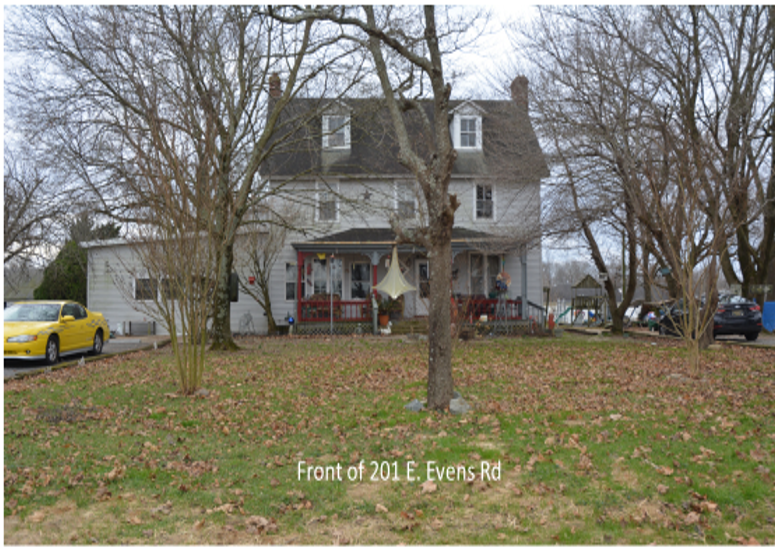

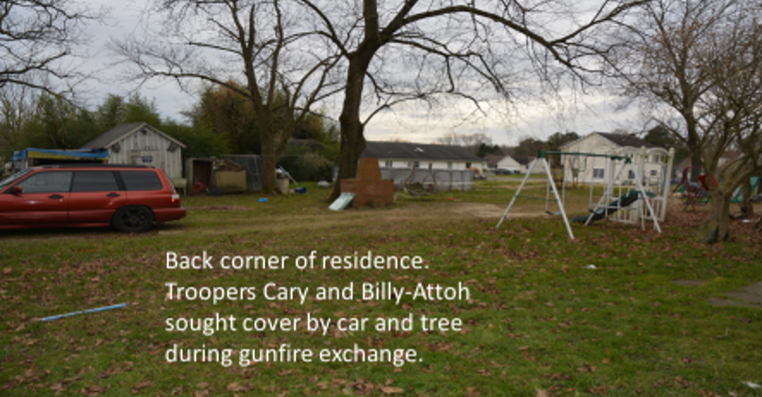



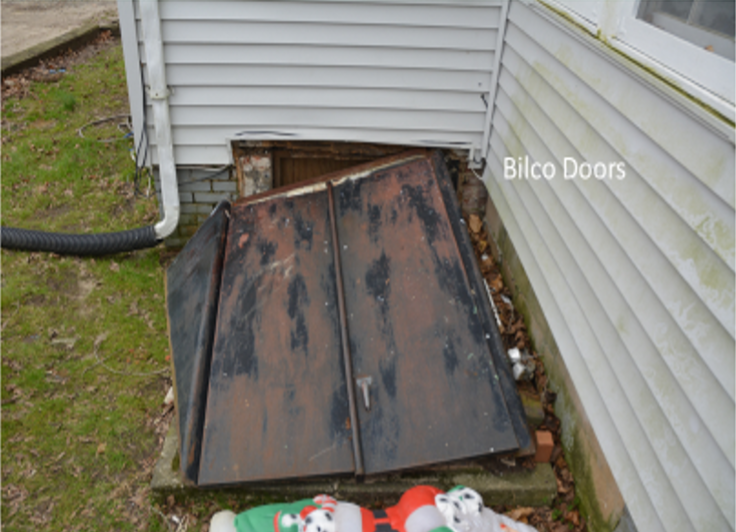
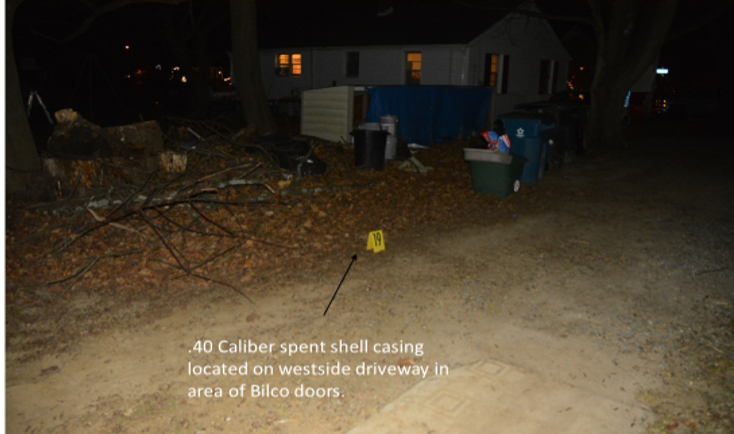
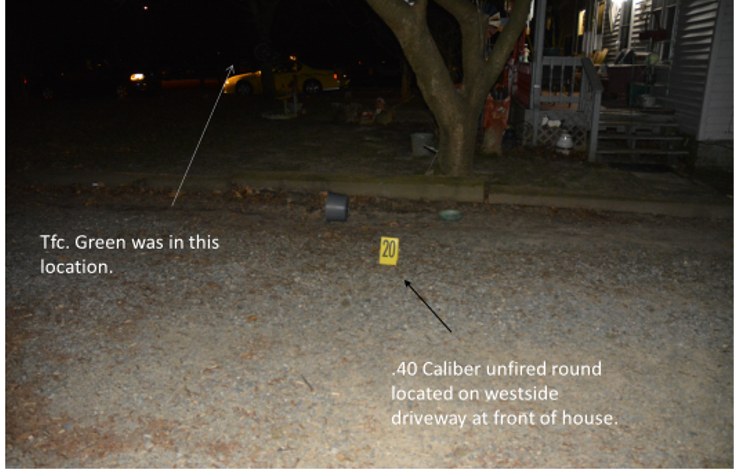

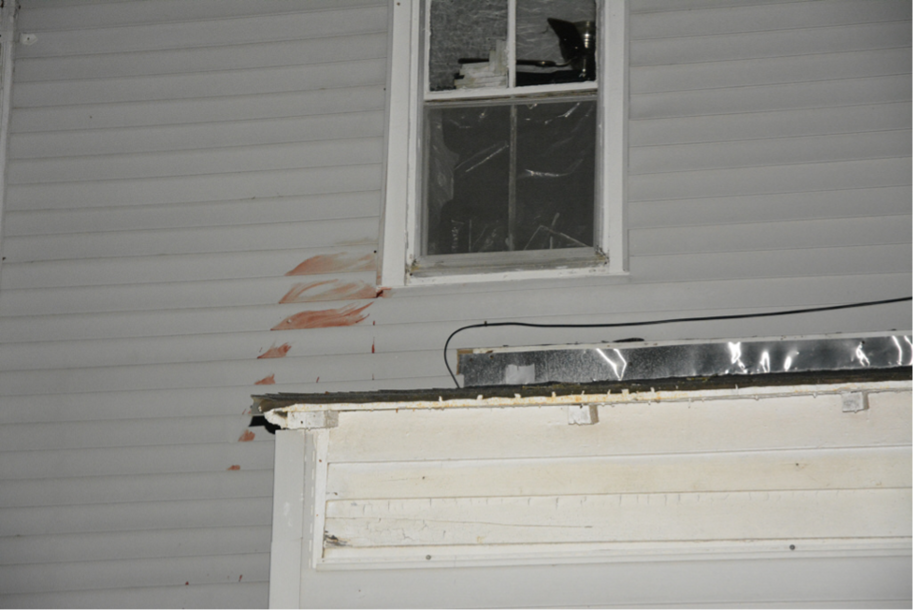


Conclusion
The State must determine whether the use of deadly force by the DSP Troopers constitutes a criminal act. Title 11 Section 464 of the Delaware Code defines the legal use of force in self- protection. It provides, in pertinent part, that “[t]he use of deadly force is justifiable under this section if the [officer] believes that such force is necessary to protect the [officer] against death or serious physical injury.”3 In a criminal case, the State must also prove beyond a reasonable doubt that an officer’s use of deadly force was not justified under Title 11 Section 465, use of force for the protection of other persons.4
Under Delaware law, the state of mind of the law enforcement officer must be considered when determining whether the use of force was justifiable against another person. The specific factual inquiry is two-pronged. The first question is whether the Troopers actually believed, at the time they intentionally fired their weapons, that such action was necessary to protect themselves or others from death or serious physical injury. The second question is whether the Troopers were reckless or negligent in having such belief, or in acquiring or failing to acquire any knowledge or belief, which is material to the justifiability of the use of force. 11 Del. C. § 470(a). If such force is determined to have been justified, the law requires an examination into whether such force negligently or recklessly created injury or risk of injury to innocent third parties pursuant to 11 Del. C. § 470(b).
Each of the three Troopers believed that their actions were necessary to protect themselves from serious physical injury or death. Cochran was armed, disobeyed police commands, and fired multiple times in the direction of the Troopers. As he attempted to flee, and after he already fired at other police officers, Cochran raised his gun toward Trooper Green, prompting Trooper Green to fire his rifle in response. Neither of Trooper Green’s rifle rounds struck Cochran.
Witnesses described Cochran as having been armed and in an agitated state prior to police arrival. Cochran was witnessed using drugs, believed to be drunk, and his toxicology report shows a significant quantity of alcohol in his system. Cochran’s state of mind as reported by witnesses was apparent when he said he was going to have a “shootout” and “the cops are going to kill me tonight.”
The police were not reckless or negligent in forming the belief that deadly force was immediately necessary in this case. Trooper Cary saw an armed, fleeing suspect, gave Cochran commands to drop his gun, and then Cochran began firing at him. Cochran continued to fire after the police returned fire. Each of Cochran’s gunshots demonstrated his intent to kill or seriously injure the police.
Because the police were justified to use force pursuant to 11 Del. C. § 464, we further determine that they were not negligent or reckless in injuring or creating a risk of injury to third persons under 11 Del. C. § 470(b). No third persons were injured and the police took reasonable measures to only use force when necessary.
Finally, SB 148 now requires as a matter of law that, if DCRPT issues a public report on the use of force, the report must include the race of the law enforcement officer who used force, the race of the individual on whom force was used, and whether race was a relevant or motivating factor. Cochran, the person against whom force was used, is a white male. Trooper Cary is a white male, Trooper Billy-Attoh is a black male, and Trooper Green is a white male. Race was not a relevant or motivating factor.5 The relevant and motivating factors to the use of force here were the reasonable belief that force was necessary due to the substantial risk of death to others that Cochran posed.
Upon careful consideration of the available evidence and the application of expert opinion to that evidence, Troopers Cary, Billy-Attoh, and Green all reasonably believed that the use of deadly force upon Cochran was immediately necessary for the purpose of protecting themselves and others. For these reasons, the Department of Justice concludes the use of deadly force in this case does not constitute a criminal offense under the laws of the State of Delaware.
Report of the Department of Justice on December 30, 2020 Use of Force by Delaware State Police
1 In this case, Cochran survived his two gunshot wounds and was indicted by a Grand Jury on two counts of Attempted Murder in the First Degree (one for Trooper Joshua Carey and one for Trooper Schatzsneider Billy- Attoh), Reckless Endangering First Degree as to Trooper Andrey Green, Burglary Second Degree, Conspiracy Second Degree, Theft of a Firearm, Criminal Mischief, Possession of a Firearm During the Commission of a Felony, Possession of a Firearm by a Person Prohibited due to a prior Robbery First Degree and Assault Second Degree conviction, and Possession of Ammunition by a Person Prohibited. “Person One” is a co-defendant with Cochran, and Person One is charged with crimes of Burglary Second Degree, Possession of a Firearm by a Person Prohibited from a prior Burglary Third Degree conviction, Theft of a Firearm, Possession of a Firearm During the Commission of the Felony of Burglary Second Degree, Theft of a Firearm and Criminal Mischief. An indictment is the charging document in a criminal case and does not itself constitute evidence of guilt.
2 Person One is a charged co-defendant with Cochran.
3 Because this event took place on December 30, 2020, the law in effect at the time is what controls the analysis. The passage of SB 147 has changed the use-of-force law, but that change was after this event and therefore does not apply.
4 “(a) The use of force upon or toward the person of another is justifiable to protect a third person when: (1) The defendant would have been justified under § 464 of this title in using such force to protect the defendant against the injury the defendant believes to be threatened to the person whom the defendant seeks to protect; and (2) Under the circumstances as the defendant believes them to be, the person whom the defendant seeks to protect would have been justified in using such protective force; and (3) The defendant believes that intervention is necessary for the protection of the other person.”
5 If race were a relevant or motivating factor in any shooting, the criminal charging analysis would include discussion of Hate Crimes under 11 Del. Sec. 1304(b).




